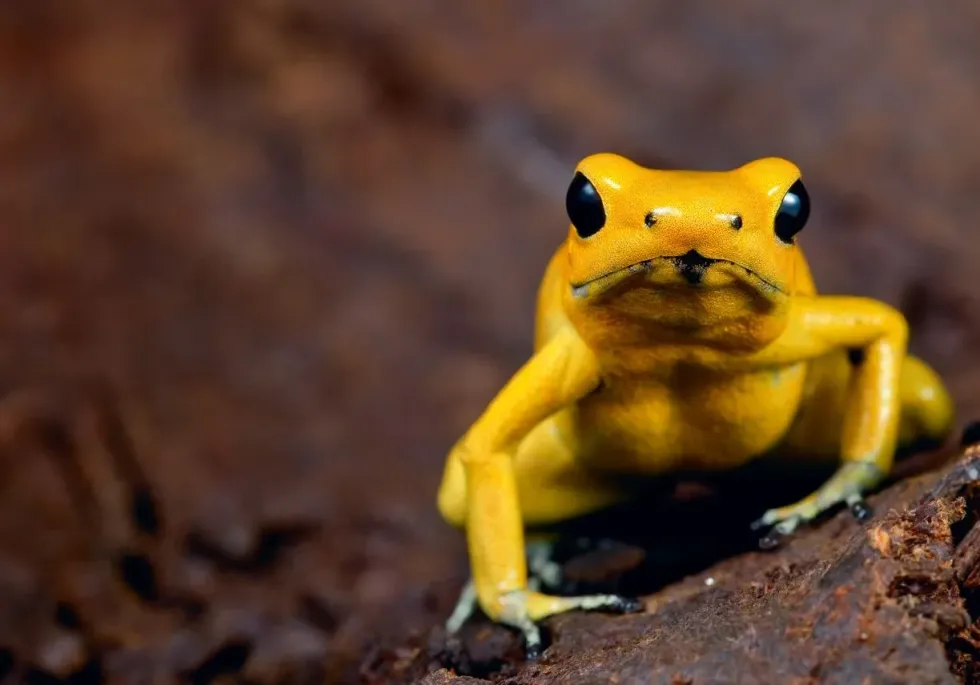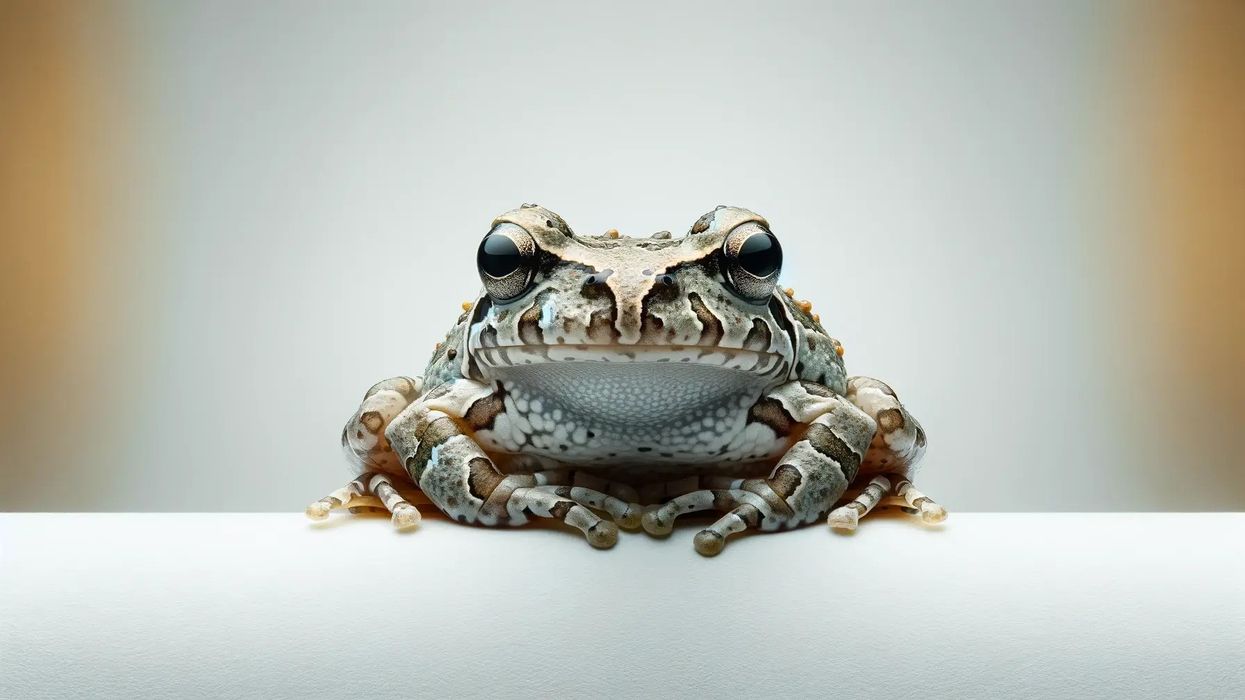Poison frog is a group of poisonous amphibians with over 175 known frog species. They are native to Amazonian rainforests, known for their vibrant colors and venom running through all over their bodies.
They receive their poisonous venom from their primary diet; the insects, making them untouchable with bare hands as the poison may leak from their skin.
Poison frog species can sweat a mixture of alkaloids from their skin, which can block transmission of nerve signals, thus leading to cardiac arrest or respiratory paralysis, and eventually killing whoever touches them. Yellow poison frogs a.k.a golden poison frogs are known to be the deadliest of them all.
They are known to live solitary lives, however, in captivity, they can live in small groups as well. Both male and female frogs become aggressive in mating sessions. They don't hesitate to engage in a brawl over ideal breeding ground and perches.
To learn more, we have collected a set of interesting facts about this species for you to read. You can also learn more about fascinating wildlife by reading up more articles on the marine toad and the bonito fish.
Poison Frog Interesting Facts
What type of animal is a Poison Frog?
Poison frogs are a group of frogs of the Dendrobatidae family.
What class of animal does a Poison Frog belong to?
Poison frogs belong to the amphibia class of the Animalia kingdom.
How many Poison Frogs are there in the world?
There are more than 100 varieties of poison frogs. However, the total count of poison frog population in our world is uncertain yet. Due to the existence of multiple species and their remote locations, it is extremely difficult to have an exact count of their population.
Where does a Poison Frog live?
Humid rainforests are the ideal geographic and climatic conditions for poison frogs to rise and shine! Poison frogs live in tropical rainforests, swamps, and lowland forests of Bolivia, Colombia, Ecuador, Panama, Venezuela, and Hawai as well.
What is a Poison Frog's habitat?
The ideal habitat of a poison frog is tropical rainforests, swamps, tropical high altitude shrublands, lakes, and swamps of central and south America. Few species can also be found in Savana, rural gardens, and other moist forests. Certain species of poison frogs live in trees as well, 11 yd (10 m) above the ground.
Who do Poison Frogs live with?
The social attributes of poison frogs vary from species to species. Some species live a solitary life. On the other hand, phyllobates and epipedobates can live in groups with harmony as well. Other amphibians like clown tree frogs and tree frogs can share territory with poison frogs.
How long does a Poison Frog live?
The average life span of a poison frog is 2-4 years. In ideal conditions, a tri-colored poison frog can live up to 20 years. In captivity and given proper nutrients, few species of poison frogs can live up to 25 years!
How do they reproduce?
Poison dart frogs can breed multiple times throughout the year. Mating seasons make both the male and female frog becomes hyperactive. A male frog competes with other males for ideal perches and females engage with each other to occupy better nesting areas.
The mating process begins after the male frog has performed their breeding call and found a female frog to mate with. The courtship ceremony of poison frogs is one of the most magnificent ones among all other species of the Animalia kingdom.
In courtship, the ceremony includes stroking, wrestling, and leading the female to the breeding spot. The female frog lays her eggs in moist leaf litter after the courtship ceremony concludes and both decide to settle.
They can lay up to 40 eggs with on average 10 eggs per clutch. The size of the egg depends on their species, usually ranging from 0.07-0.12 in.
The male frog externally fertilizes the eggs and together they protect their eggs with watchful eyes as female poison frogs tend to eat others' eggs! The tadpoles hatch out of their eggs after 10-18 days after fertilization.
An amazing fact is many species of poison frogs are very dedicated and responsible parents! They carry their newborn into the canopy. After a brief period, the mother deposits her babies in a pool and the tadpoles feed on invertebrates. The mother even lays more eggs in the pool to supplement their diet.
What is their conservation status?
Most of the poison frog species are Near Threatened. Golden poison frogs are listed as Endangered Species by the International Union For Conservation of Nature (IUCN) Red List. The Splendid poison arrow frog is an Extinct species today. They are being protected at the National amphibian conservation center in Michigan and Smithsonian's National Zoo.
Poison Frog Fun Facts
What do Poison Frogs look like?

Whenever you ask someone what do they think poison frogs look like, the first answer is about their vibrant and bright colors. Yes, when we think about them, every time we get mesmerized by the amazingly bright colors and patterns on their skin.
However, it means something else in their habitat. Their vibrant colors are a warning to their predators about them being poisonous.
'Aposematic coloration' is the scientific term for those animals who have bright colors to warn their predators.
Every species have different colors and patterns and there is no doubt that they look extremely gorgeous! Strawberry poison frogs have blue legs and a bright red-colored body and the biggest of all of them, the golden poison frog is of bright golden yellow color.
How cute are they?
There is no denial that poison dart frogs look extremely cute and adorable. However, if you are thinking about catching one with your hands and pat them, you better check with your insurance agent first, as toxins run through their entire body. Their poison makes them too toxic to touch.
How do they communicate?
A poison dart frog communicates by making different sounds for many purposes, such as announcing territory, attract the opposite gender, and express various emotions. A male poison dart frog can use his vocal sac as a resonating chamber. With years of research, biologists have confirmed that different species of poison frogs have their particular language.
How big is a Poison Frog?
The average size of a poison frog is 1 - 1.5 in (2.5 - 3.8 cm). The golden poison frog is the largest of them all. Female golden poison frogs can grow 0.5-1 in larger than male frogs.
How fast can a Poison Frog run?
There is no exact measurement of how fast can a poison frog run. It has been observed that a poison frog can attack its prey with unbelievable speed and accuracy, given the prey no time to dodge or counter it.
How much does a Poison Frog weigh?
The weight of a poison frog depends on its species and diet. A poison frog can weigh 0.004-0.008lb (2-4g), with the golden poison frog being the heaviest of all of them, can weigh up to 0.015 lb (7 g). Poison frogs who are affected by the chytrid fungus, lose their weight drastically.
What are their male and female names of the species?
There is no particular name given to the male and female poison frogs respectively.
What would you call a baby Poison Frog?
Baby poison frogs are called tadpoles.
What do they eat?
A large number of poison frogs are insectivores. They use their tongue to capture their prey. They have been proven fast enough to catch their prey with the element of surprise! However, they do not attack insects larger than the size of a full-grown cricket or insects larger than their size.
Their diet includes insects, spiders, worms, and ants. Tadpoles can eat algae as well, which makes them omnivorous.
As mentioned earlier, tadpoles can eat unfertilized eggs, which their mother lays. The practice of cannibalism is common between splash-back poison frogs. It is believed that Poison arrow frogs get their toxic venom from the insects they eat, however, it is not clear how or which particular insect or insects make them toxic.
Are they dangerous?
The word 'poison' on their name already answers the question. The golden poison frog or yellow poison frog has enough poison to kill 20,000 mice or 10 full-grown men.
The toxic venom runs through their skin, which is why touching them with bare hands can be a nightmare. The Embera clan, native to Colombia, used to dip their arrow and darts in dart frog poison to kill animals. Thus giving them their name poison arrow frogs/poison dart frogs.
Would they make a good pet?
It is a never-ending debate. There is no doubt these animals can be poisonous enough to harm, however, in captivity, many poison frogs didn't show any signs of toxicity!
It is theorized that their venom comes from the insects they eat but the captive ones who were fed only cricket and flies didn't release any venom from their skin. They also are pretty easy to take care of, with gloves on of course.
Did you know...
Poison frog species don't make poisons themselves. They get it from the insects they devour.
Poison frogs use toxic alkaloid poisons. All frogs of the Anura order can produce poisonous skin secretions and not just the adult frogs but also tadpoles can be poisonous as well. The tadpoles can absorb poisons from their parents' skin and become poisonous themselves.
Frog poison equivalent to two grains of salt is enough to kill a person.
How far can they jump?
Green and black poison frogs can jump over 130 in or 3.3 m in one leap! They are blessed with this ability to avoid predators and capture their prey.
What do Poison Frogs sound like?
The intensity and loudness of their sound depends on the species. To some, it may sound like an old pager! They make different sounds to communicate with each other and express different emotions.
What is an interesting fact about Poison Dart Frogs?
Poison frogs can be the main attraction of any zoo or aquarium displaying them. The San Diego Zoo, Smithsonian's National Zoo, Seneca park zoo, and Reid park zoo have poison frogs on display. In there they are feed on insects that will never produce any type of toxins and handled with care with gloves worn by zookeepers.
Here at Kidadl, we have carefully created lots of interesting family-friendly animal facts for everyone to discover! Learn more about some other amphibians including pool frog, or caecilian.
You can even occupy yourself at home by drawing one on our Poison Frog coloring page.









